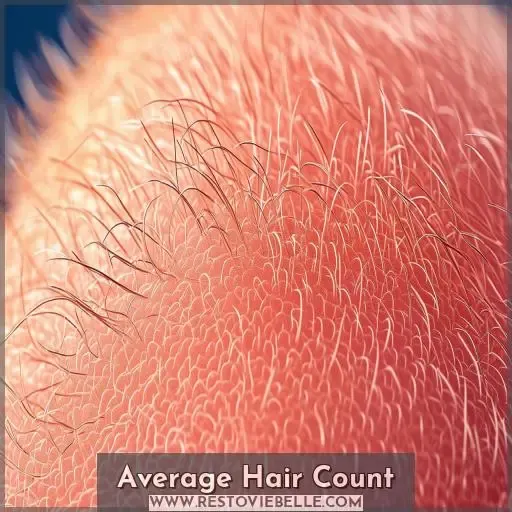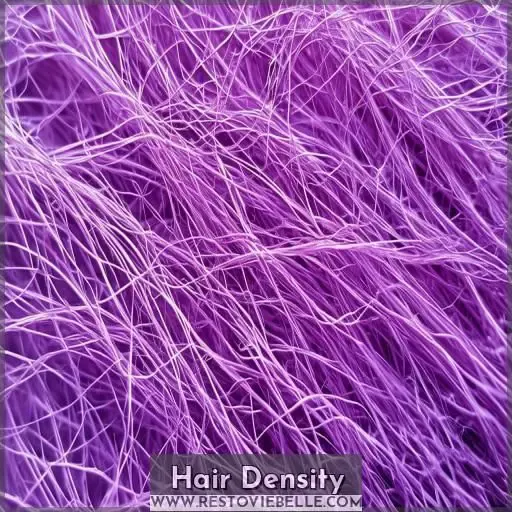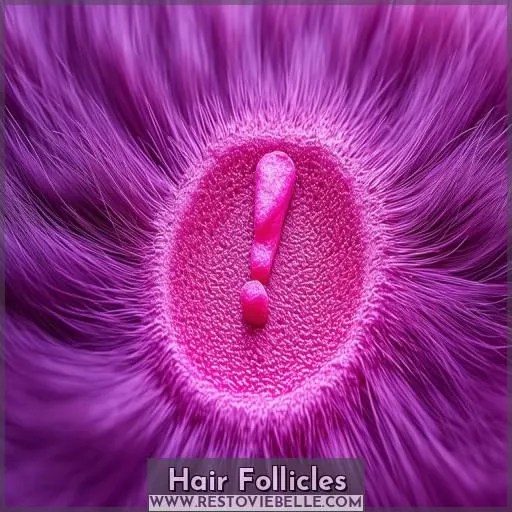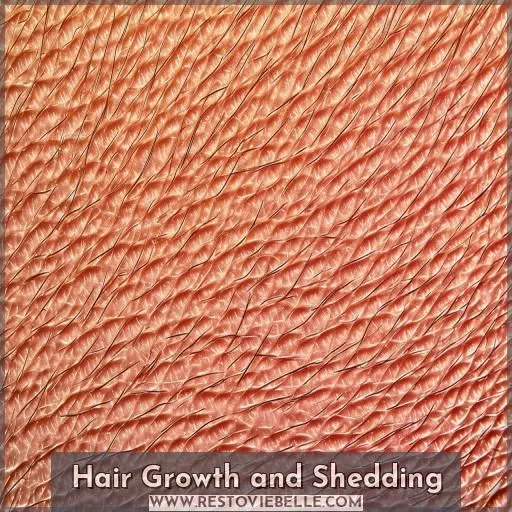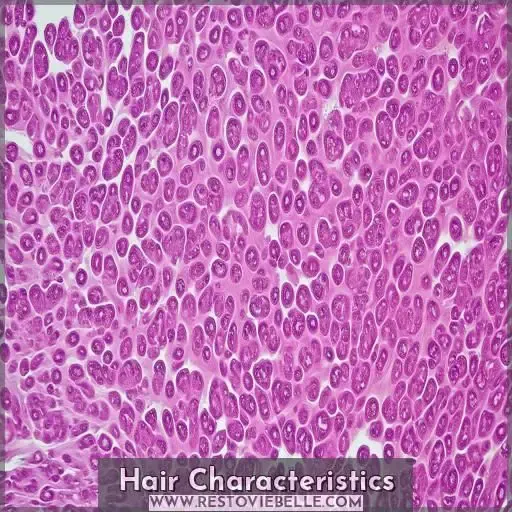This site is supported by our readers. We may earn a commission, at no cost to you, if you purchase through links.
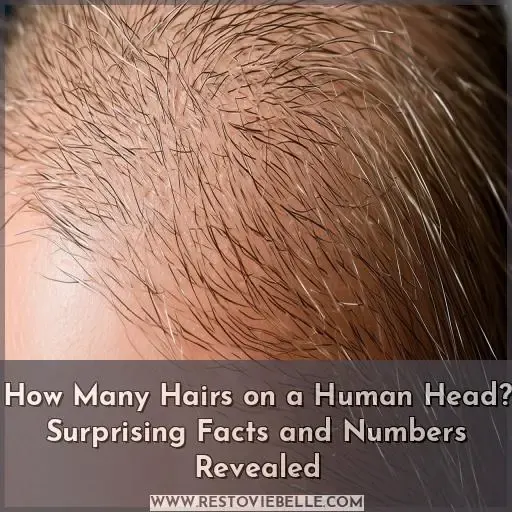 You probably think you have an innumerable amount of hair strands on your head, but the average is around 100,000. Blondes tend to have more at 140,000, while redheads have fewer at 90,000.
You probably think you have an innumerable amount of hair strands on your head, but the average is around 100,000. Blondes tend to have more at 140,000, while redheads have fewer at 90,000.
Your hair density, ranging from 800-1,290 hairs per square inch, depends on genetics, hormones, age, and health.
These hairs sprout from 100,000 evenly distributed follicles that cycle through growth phases. With a growth rate of 0.5 inches per month and normal shedding of 50-100 hairs daily, maintaining your crowning glory takes work.
But keep reading to unravel more surprising hair facts.
Table Of Contents
Key Takeaways
- Heads up, your "crowning glory" actually consists of around 100,000 individual strands – not innumerable as you might have thought! That’s just enough to maintain your luscious locks while avoiding looking like a troll doll.
- Blondes, brunettes, and redheads all rock different hair counts, with blondes boasting around 140,000 strands, and those fiery redheads on the lower end with around 90,000. Just Mother Nature’s way of keeping things balanced, I suppose!
- Your hair density, or how many strands are packed into each square inch of your scalp, can range from 800 to 1,290 – with the lucky ducks sporting thicker hair getting the higher number. It’s like a game of follicle Tetris up there!
- Those 100,000 follicles on your head are busy little bees, cycling through growth phases and shedding 50-100 strands daily. No need to panic over a few stray hairs in the shower drain – it’s all part of the hair life cycle!
How Many Hairs on a Human Head?
How many hairs on a human head? The average adult human head has around 100,000 to 150,000 hairs. However, the exact number varies depending on factors like hair density, follicle count, and individual hair characteristics.
Average Hair Count
You may be surprised to learn that the average human head has about 100,000 hairs! However, this number can vary considerably between individuals.
Blondes tend to have the most, with around 140,000 hairs, while redheads often have the least, averaging around 90,000. Brunettes generally fall in the middle at 100,000.
This variation is due to the unique distribution of hair follicles on each person’s scalp.
Curiously, this "pigeonhole principle" suggests that with over 8 billion people on Earth, at least two individuals must share the exact same hair count! So while your hair count is distinctly yours, it’s likely matched by someone, somewhere in the world.
Hair Density
You typically have between 800-1,290 hairs per square inch on your head. The density depends on factors like hair thickness – thicker hair means more hairs packed into the same area, while finer hair results in fewer hairs per square inch.
Hairs Per Square Inch
You’ve likely noticed differences in hair thickness, even on your own head. The number of hairs per square inch, or hair density, actually varies quite a bit:
- Average range: 800-1,290 hairs/sq inch
- Thick hair: 1,000+ hairs/sq inch
- Fine hair:
Factors Affecting Density
Your hair density depends on genetics, hormones, age, and health. Blondes tend to have finer, less dense hair, while brunettes and redheads often have thicker, denser locks. Proper nutrition also affects density, following Stigler’s Law. Notably, the Pigeonhole Principle illustrates that at least two people share the same hair count, like Gödel’s Incompleteness Theorems revealing complex systems’ simplicity.
Hair Follicles
You’re born with around 100,000 hair follicles on your scalp—these tiny pouches are where each individual strand grows from. The follicles cycle through different phases, and disruptions in this cycle can lead to thinning hair or hair loss.
Number of Follicles
You’ve got around 100,000 hair follicles on your head. These little pouches in your skin are evenly distributed, with some variation based on genetics. Maintaining follicle health is key – disruptions can lead to thinning or loss. Fun fact: Applying Stigler’s law, the average head hair count was likely first discovered long before it was formally documented.
Follicle Cycle
Your hair follicles have a cyclical lifespan involving these phases:
- Anagen (growth)
- Catagen (transition)
- Telogen (resting)
Each follicle independently progresses through this cycle, with the anagen phase lasting 2-7 years before shedding the hair. Maintaining proper follicle activity and development is key for healthy hair growth.
Hair Loss and Follicles
Maintaining a healthy crop of follicles is key to preventing hair loss. You’re born with a finite number, so treat them kindly by avoiding harsh chemicals, minimizing stress, and getting proper nutrition. If follicles shut down prematurely, hair transplants or medications can restore density – but prevention is ideal. Monitor your scalp’s follicle health closely for the best results.
Hair Growth and Shedding
The average hair growth rate is approximately 6 inches per year, with male hair growing faster than female hair. While losing 50-100 hairs per day is considered normal shedding, excessive hair loss can result from various factors, including hormonal imbalances, stress, medical conditions, and disruptions in the hair growth cycle.
Growth Rate
Your hair goes through cycles of growth and rest. On average, your hair grows around 0.5 inches (1.25 cm) per month. However, factors like:
- Age
- Genetics
- Hormones
- Nutrition
Influence your individual growth rate. Understanding the hair growth cycle helps manage expectations and pinpoint potential issues.
Shedding Rate
While losing 50-100 strands daily is considered normal, excessive shedding could signify underlying hair loss causes. Consult professionals if you notice thinning patches or overall volume reduction. Treatments like minoxidil stimulate follicles, promoting regrowth. With proper care and addressing root issues, you can revive your luscious locks.
Factors Affecting Growth
Your hair growth is influenced by age, nutrition, hormones, stress, and sleep. As you age, hair growth slows, and thinning may occur. Ensuring proper nutrition with protein, vitamins, and minerals supports healthy hair growth. Hormonal changes, like during pregnancy or menopause, can impact hair growth. Chronic stress and lack of sleep disrupt the hair growth cycle, leading to:
- Excessive shedding
- Stunted growth
- �multimedia hairloss
Focus on managing these factors for ideal hair health and growth.
Hair Characteristics
Your hair color is determined by the pigment melanin produced in your hair follicles, with blondes having the least melanin and redheads the most. The thickness and texture of your hair strands is also influenced by the shape, size, and distribution of your hair follicles, as well as genetic factors.
Hair Color
Your hair color is determined by genetics, but fashion trends and cultural significance also play a role. Dyeing or bleaching can drastically change your natural hue, though these processes may damage hair over time. Embrace your color – whether blonde, brunette, redhead, or going gray – it’s a part of your identity.
Hair Texture
Your hair texture depends on your follicles’ shape and how tightly your hair strands cluster together. Fine hair feels smooth, while coarser hair feels thicker and rougher. Hair porosity affects styling; porous hair absorbs moisture and products easily. Styling techniques like heat, chemicals, and extensions can damage and alter hair texture over time.
Hair Strength
A single strand of hair can withstand an impressive 3.5 ounces of tension before breaking! But be gentle when your hair is wet – it weighs up to 18% more and stretches 30% longer than dry hair, making it more vulnerable. Nourish those 5 million body hair follicles for robust strands, though your palms, soles, and lips will remain hairless.
Frequently Asked Questions (FAQs)
Are bald people considered to have no hairs?
No, bald people aren’t considered hairless. Even without visible scalp hair, tiny vellus hairs cover most of your body. Plus, hair follicles remain, though dormant. So while balding reduces hair volume, you’re never truly hairless.
Does hair color affect the growth rate?
Yes, hair color can affect growth rate. Generally, brunettes’ hair grows faster than blondes’ or redheads’. But individual variations occur based on genetics and overall health.
Can hormones influence the number of hairs?
Yes, hormones can influence hair count. Hormones like testosterone, estrogen, and thyroid hormones play a role in regulating the hair growth cycle and follicle health. Imbalances can contribute to excessive hair loss or growth.
How does age impact hair density?
As you age, your hair follicles shrink slightly, resulting in a gradual decline in hair density over time. Hair also tends to become thinner and more brittle with age.
What causes some people to have thicker hair?
Like strands of silk, the thickness of your hair is intricately woven by genetics – some follicles produce thicker, more voluminous locks while others craft finer, delicate strands.
Conclusion
From humble follicles emerges your crowning glory—the approximately 100,000 hairs adorning your head. This intricate tapestry varies in density, color, and texture due to genetics and environmental factors. Maintaining ideal hair health requires understanding growth cycles, shedding rates, and caring for each strand. By unraveling these surprising hair facts, you’re better equipped to nurture your lustrous locks.

